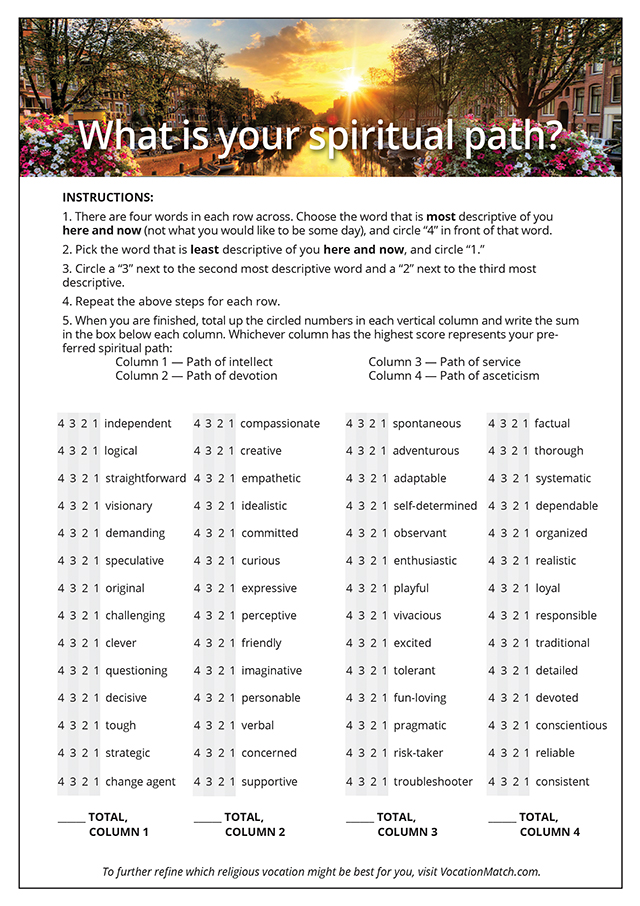A spirituality for every temperament

There are four main pathways that are anchors in the Catholic spiritual tradition and worth exploring in some depth to help you understand your spiritual preferences.
THROUGHOUT HISTORY spiritual directors have warned against casting spiritual seekers into one mold. Saint Ignatius Loyola said there is “no greater mistake in spiritual matters than to force others to follow one’s own pattern.”
Many observers have noted four main dispositions, or temperaments, that help describe how people behave on their spiritual journey: the path of intellect, the path of devotion, the path of service, and the path of asceticism. These four main pathways are anchors in the Catholic spiritual tradition and worth exploring in some depth to help you understand your own spiritual preferences. What helps you develop spiritually may be dramatically different from what attracts the person next to you.
Take the quiz here (or see below) to find your spirituality type. Your quiz results may confirm what you already know about your spiritual leanings, or you may feel called to explore a different pathway. Consider your results an invitation to know yourself better and experiment with different forms of prayer, worship, and meditation. It is best to not feel bound by or limited by your result—your spirituality could very well be a combination of these four pathways. It is merely a tool to give you more insight into your preferences when it comes to living out your Christian call.
Religious orders represent a rich multitude of spiritualities drawing on these traditions but their spirituality is also far more nuanced and complex than these categories. Do not limit your exploration of religious communities to the traditions and saints associated with these spiritual paths. Simply use it as a starting point. Remember: Drawing closer to God and unraveling the mystery of God is the work of a lifetime.
Now, please take the quiz to see which of the four basic spiritual paths you currently find yourself drawn to.

Your quiz results explained:
Path of intellect (Thomistic prayer)
The method of Saint Thomas Aquinas is known as scholastic prayer. The main emphasis is on the orderly progression of thought from cause to effect. People drawn to this prayer type prefer neat, orderly forms of the spiritual life as opposed to the more free-spirited attitude of the Franciscan approach. Their spirituality is centered on the earnest pursuit of all the transcendental values: truth, goodness, beauty, unity, love, life, and spirit. Like Saint Teresa of Ávila, they are willing to exert superhuman effort to achieve their goal.
Because of their disdain for second best, they seek total truth and authenticity in their lives and work hard to reach the whole truth about themselves, about God, and about sanctity. This intense pursuit of truth colors their whole spiritual life.
Books of prayer frequently call the Thomistic method of prayer “discursive meditation.” In this type of prayer one takes a virtue, fault, or theological truth and studies it from every possible angle. Change of behavior is an essential part of this prayer—it doesn’t stay at the intellectual level.
Path of devotion (Augustinian prayer)
This pathway to spiritual growth uses creative imagination to transpose the world of scripture to today’s situation—as if the scripture passage is a personal letter from God addressed to each one of us (like Saint Augustine picking up Romans 13 and reading a message pointed directly at him). The essential element of this spirituality, going back to New Testament times (Jesus, Saint Paul, and the early church leaders), is experiencing a personal relationship with God. Because they read between the lines and catch what is inexpressible and spiritual, those who follow the path of devotion understand symbols and their use in liturgy.
This path concentrates on meditations that loosen the feelings and expand the ability to relate to and love others. The stress is on the love of self, others, and God. Those on this path can follow the four steps of lectio divina: listen to what God says in scripture; reflect prayerfully and apply it to today; respond to God’s word with personal feelings; remain quiet and stay open to new insights.
Path of service (Franciscan prayer)
Like Saint Francis of Assisi, those who follow this path must be free, unconfined, and able to do whatever their inner spirit moves them to do. One thinks of Saint Peter impetuously jumping into the water to join Jesus as a typical action of this type.
Franciscan spirituality leads to acts of loving service that can be a most effective form of prayer. The gospel stories about Jesus have a special appeal, particularly the Incarnation of God in the life of Jesus, which is the center around which Franciscan life and spirituality revolve. Franciscan prayer is flexible and free-flowing, making full use of the five senses; it is spirit-filled prayer.
Those on this path can make a meditation on the beauty of a waterfall, flower, meadow, mountain, or ocean—all of God’s creation. There is more stress in prayer on the events of Jesus’ life rather than his teaching. Like Saint Thérèse of Lisieux, prayer is done with total concentration. It is the most important thing to be doing at this moment. Thérèse did all tasks knowing that each was a part of the total harmony of the universe.
Path of asceticism (Ignatian prayer)
This pathway involves imagining oneself as part of a scene in order to draw some practical fruit from it for today. This spirituality goes back to the Israelite way of praying in 1000 B.C. in which one remembers and immerses oneself in an event and thus relives and participates in the event in a symbolic way.
That is how Saint Ignatius of Loyola meditated on the figures in the Nativity scene: ‘’I will make myself a poor, little, unworthy servant, and as though present, look upon them, contemplate them, and serve them in their needs with all possible homage and reverence. Then I will reflect on myself that I may reap some fruit.’’
Ignatius’ preoccupation with order was evident in his Spiritual Exercises, which he aimed at overcoming “disorderly affections, so that [people] may make a decision that is in keeping with God’s will,” says Thomas Clarke in Playing in the Gospel. According to Clarke, “Most souls who are willing to endure the discipline of the 30 days of intense prayer activity of the Spiritual Exercises are rewarded with an unforgettable spiritual experience that frequently changes the whole direction of their lives.”
Related article: VocationNetwork.org, “A user’s guide on the ways to pray.”
Download a pdf of the quiz for use in classrooms, parishes, retreats settings.
Tags
- spiritual journey
- path of intellect
- path of devotion
- path of service
- path of asceticism
- catholic spiritual tradition
- thomistic prayer
- augustinian prayer
- franciscan prayer
- ignatian prayer
Related
- Questions Catholics Ask: What are the different forms of prayer?
- What does “success” look like in discernment?
- How to find a guide for your vocation adventure
- Beware of bots and bad actors as you engage online
- Call stories to help you discern
- Five reasons to pray the Liturgy of the Hours
- Tune into your prayer life
- Embody your decisions
- Your mission awaits you! Pope Francis' message to young people
- My portable prayer life Read More
Most Viewed
- Find your spirituality type quiz
- Questions and answers about religious vocations
- Celibacy quiz: Could I be a nun? Could I be a brother? Could I be a priest?
- Resources for older discerners or those with physical and developmental differences
- About Vocation Network and VISION Guide

